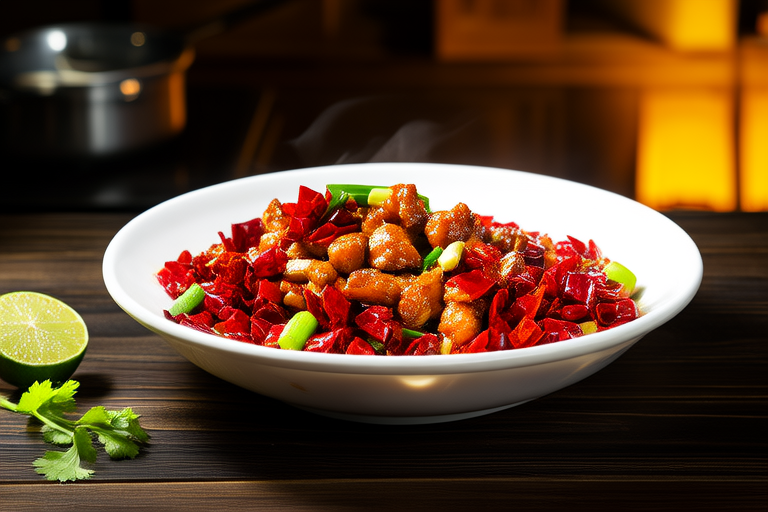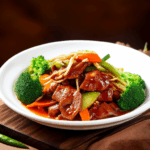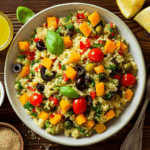- Introduction to Spicy Kung Pao Chicken
Spicy Kung Pao Chicken: A Fiery Delight
For many food enthusiasts, the spicy Kung Pao chicken is not just a dish; it’s an experience. It is one of the most popular dishes in Chinese cuisine and has been enjoyed by people all over the world for decades. The name “Kung Pao” comes from the Qing Dynasty official Ding Baozhen, who was known for his fiery personality and sharp tongue. This dish is characterized by its bold flavors, with a perfect balance of sweet, sour, and spicy notes. In this article, we will explore the history, ingredients, preparation techniques, and tips for cooking the perfect spicy Kung Pao chicken.
- The History of Kung Pao Chicken
The origins of Kung Pao chicken can be traced back to Sichuan Province in southwestern China. The dish was originally made with diced chicken, peanuts, dried red peppers, and vegetables. Over time, variations of the dish have emerged, with different regions adding their own unique touches. Today, Kung Pao chicken is enjoyed in various forms around the world, with some versions using beef or tofu instead of chicken. Despite these variations, the core ingredients and flavors remain the same, making it a beloved dish for many.
- Ingredients for Spicy Kung Pao Chicken
To prepare the perfect spicy Kung Pao chicken, you’ll need the following ingredients:
- Chicken: Use boneless, skinless chicken breast or thighs. You can also use a combination of both for added flavor.
- Peanuts: Toasted or raw peanuts add crunch and nuttiness to the dish.
- Dried red peppers: These provide the heat and spice that give Kung Pao chicken its signature kick. Be sure to adjust the quantity according to your preference for spiciness.
- Garlic: Minced garlic adds depth and aroma to the dish.
- Ginger: Fresh ginger provides a subtle warmth and complements the other spices.
- Soy sauce: Dark soy sauce adds color and umami to the dish.
- Vinegar: Rice vinegar or white wine vinegar gives the dish a tangy flavor.
- Sugar: Granulated sugar balances the acidity of the vinegar and adds sweetness.
- Cooking oil: Vegetable oil or peanut oil works well for frying the chicken and cooking the sauce.
- Scallions: Chopped scallions add freshness and color to the finished dish.
- Seasonings: Salt, pepper, and sesame oil enhance the overall flavor profile.
- Preparation Techniques for Spicy Kung Pao Chicken
Before you begin cooking, it’s important to prepare the ingredients properly. Start by cutting the chicken into bite-sized pieces and marinating them in a mixture of soy sauce, rice wine, salt, and cornstarch. Let the chicken sit for at least 30 minutes to allow the flavors to penetrate. While the chicken is marinating, prepare the other ingredients. Slice the ginger and garlic, chop the scallions, and toast the peanuts if desired.
Next, make the sauce. In a small bowl, whisk together soy sauce, rice vinegar, sugar, and a small amount of water to create a smooth, flavorful sauce. Set aside until ready to use.
Heat a wok or large skillet over high heat and add enough oil to coat the bottom. Once the oil is hot, add the chicken and stir-fry until it turns golden brown and is cooked through. Remove the chicken from the pan and set it aside.
In the same pan, add more oil if necessary, then stir-fry the garlic, ginger, and dried red peppers until fragrant. Add the vegetables and cook until they are slightly softened but still crisp. Return the chicken to the pan and pour in the prepared sauce. Stir everything together and cook for another minute or two until the sauce thickens and coats the chicken evenly.
- Tips for Cooking the Perfect Spicy Kung Pao Chicken
Here are some tips to help you achieve the best results when making spicy Kung Pao chicken:
- Use fresh ingredients: Fresh chicken, garlic, ginger, and vegetables will yield the best flavor.
- Adjust the spiciness: If you prefer a milder version of the dish, reduce the amount of dried red peppers or omit them entirely.
- Marinate the chicken: Marinating the chicken in soy sauce and rice wine helps to tenderize the meat and infuse it with flavor.
- Stir-fry quickly: High heat and quick cooking times ensure that the chicken remains juicy and the vegetables retain their crunch.
- Balanced flavors: Pay attention to the balance of sweet, sour, and spicy flavors in the sauce. Taste as you go and adjust accordingly.
- Toast the peanuts: Toasting the peanuts before adding them to the dish enhances their flavor and texture.
- Serving Suggestions
Spicy Kung Pao chicken pairs wonderfully with steamed rice, noodles, or dumplings. You can also serve it with a side salad or vegetable stir-fry for a more balanced meal. For a truly authentic experience, try pairing it with a glass of cold beer or a cup of green tea.
- Conclusion
Spicy Kung Pao chicken is a dish that combines bold flavors and textures to create a memorable culinary experience. By following the steps outlined in this guide, you can prepare a delicious and authentic version of this classic Chinese dish right in your own kitchen. Whether you’re a seasoned chef or a beginner, making spicy Kung Pao chicken is a rewarding and enjoyable process that will leave your taste buds satisfied.


